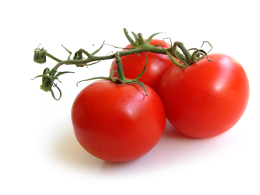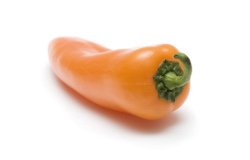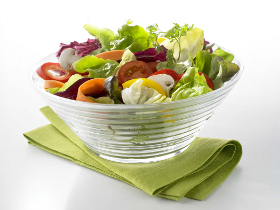
The noun vegetable usually means an edible plant or part of a plant other than a sweet fruit or seed. This usually means the leaf, stem, or root of a plant.
Some vegetables can be consumed raw, some may be eaten raw or cooked, and some must be cooked in order to be edible. Vegetables are most often cooked in savory or salty dishes. However, a few vegetables are often used in desserts and other sweet dishes, such as rhubarb pie and carrot cake.
As an adjective, the word vegetable is used in scientific and technical contexts with a different and much broader meaning, namely of "related to plants" in general, edible or not — as in vegetable matter, vegetable kingdom, vegetable origin, etc. The meaning of "vegetable" as "plant grown for food" was not established until the 18th century.
"Vegetable" comes from the Latin vegetabilis (animated) and from vegetare (enliven), which is derived from vegetus (active), in reference to the process of a plant growing. This in turn derives from the Proto-Indo-European base *weg- or *wog-, which is also the source of the English wake, meaning "become (or stay) alert".
The word "vegetable" was first recorded in English in the 15th century, but applied to any plant. This is still the sense of the adjective "vegetable" in science. The related term vegetation also has a similarly broad scope.
Nutrition
Vegetables are eaten in a variety of ways, as part of main meals and as snacks. The nutritional content of vegetables varies considerably, though generally they contain little protein or fat, and varying proportions of vitamins, provitamins, dietary minerals, fiber and carbohydrates. Vegetables 
contain a great variety of other phytochemicals, some of which have been claimed to have antioxidant, antibacterial, antifungal, antiviral and anticarcinogenic properties.
However, vegetables often also contain toxins and antinutrients such as α-solanine, α-chaconine, enzyme inhibitors (of cholinesterase, protease, amylase, etc.), cyanide and cyanide precursors, oxalic acid, and more. Depending on the concentration, such compounds may reduce the edibility, nutritional value, and health benefits of dietary vegetables. Cooking and/or other processing may be necessary to eliminate or reduce them.
Eating diets containing sufficient amounts of fruits and vegetables can help lower your risk of heart diseases and type 2 diabetes. Doing this may also protect against some cancers and decrease bone loss. Also, getting potassium (plentiful in both fruits and vegetables) will help prevent the forming of kidney stones.
Color pigments
The green color of leafy vegetables is due to the presence of the green pigment chlorophyll. Chlorophyll is affected by pH and changes to olive green in acid conditions, and bright green in alkaline conditions. Some of the acids are released in steam during cooking, particularly if cooked without a cover.
cover.
The yellow/orange colors of fruits and vegetables are due to the presence of carotenoids, which are also affected by normal cooking processes or changes in pH.
The red/blue coloring of some fruits and vegetables (e.g. blackberries and red cabbage) are due to anthocyanins, which are sensitive to changes in pH. When pH is neutral, the pigments are purple, when acidic, red, and when alkaline, blue. These pigments are very water soluble.
Safety
For food safety, the CDC recommends proper fruit handling and preparation to reduce the risk of food contamination and foodborne illness. Fresh fruits and vegetables should be carefully selected. At the store, they should not be damaged or bruised and pre-cut pieces should be refrigerated or surrounded by ice. All fruits and vegetables should be rinsed before eating. This recommendation also applies to produce with rinds or skins that are not eaten. It should be done just before preparing or eating to avoid premature spoilage. Fruits and vegetables should be kept separate from raw foods like meat, poultry, and seafood, as well as any cooking utensils or surfaces that may have come into contact with them (e.g. cutting boards). Fruits and vegetables, if they are not going to be cooked, should be thrown away if they have touched raw meat, poultry, seafood or eggs. All cut, peeled, or cooked fruits and vegetables should be refrigerated within 2 hours. After a certain time, harmful bacteria may grow on them and increase the risk of foodborne illness.
Storage
Proper post harvest storage aimed at extending and ensuring shelf life is best effected by efficient cold chain application. All vegetables benefit from proper post harvest care
Many root and non-root vegetables that grow underground can be stored through winter in a root cellar or other similarly cool, dark and dry place to prevent mold, greening and sprouting. Care should be taken in understanding the properties and vulnerabilities of the particular roots to be stored. These vegetables can last through to early spring and be nearly as nutritious as when fresh.
During storage, leafy vegetables lose moisture, and the vitamin C in them degrades rapidly. They should be stored for as short a time as possible in a cool place, in a container or plastic bag.
Vegetarianism 
Vegetarianism is the practice of following a plant-based diet including fruits, vegetables, cereal grains, nuts, and seeds, mushrooms, with or without dairy products and eggs. A vegetarian does not eat meat, including red meat, game, poultry, fish, crustacea, and shellfish, and may also abstain from by-products of animal slaughter such as animal-derived rennet and gelatin. As some cheeses containing rennet, and gelatin-derived products, contain unfamiliar animal ingredients, however, these products may unknowingly be consumed by vegetarians.
![]()
Proper post harvest storage aimed at extending and ensuring shelf life is best effected by efficient cold chain application. All vegetables benefit from proper post harvest care[17]
Many root and non-root vegetables that grow underground can be stored through winter in a root cellar or other similarly cool, dark and dry place to prevent mold, greening and sprouting. Care should be taken in understanding the properties and vulnerabilities of the particular roots to be stored. These vegetables can last through to early spring and be nearly as nutritious as when fresh.
During storage, leafy vegetables lose moisture, and the vitamin C in them degrades rapidly. They should be stored for as short a time as possible in a cool place, in a container or plastic bag.
Disclaimer: This website is for information purposes only. By providing the information contained herein we are not diagnosing, treating, curing, mitigating, or preventing any type of disease or medical condition. Before beginning any type of natural, integrative or conventional treatment regime, it is advisible to seek the advice of a licensed healthcare professional.



























